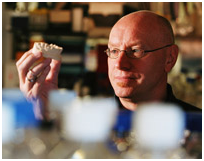Could an Alzheimer’s drug be the key to dental regeneration?: an interview with Paul Sharpe

In this interview, Professor Paul Sharpe (King’s College London; London, UK) discusses his recent study showing that damaged teeth can be persuaded to repair themselves with encouragement from a known Alzheimer’s drug, tideglusib.
In this interview, Professor Paul Sharpe (King’s College London; London, UK) discusses his recent study, published in Scientific Reports, showing that damaged teeth can be persuaded to repair themselves using a known Alzheimer’s drug, tideglusib.

Professor Paul Sharpe
Paul Sharpe, Dickinson Professor of Craniofacial Biology, is head of the Craniofacial Development and Stem Cell Biology department at the Dental Institute, Guys Hospital (London, UK) and also works at the MRC Centre for Transplantation (King’s College London; London UK) where he studies the immunosuppressive properties of the molecule PDL-1. He obtained his PhD from the University of Sheffield (Sheffield; UK) and conducted postdoctoral research in Sheffield and Cambridge. His current research topics include studying the in vivo behavior and functions of mesenchymal stem cells found in teeth. He is also studying cell-based alternatives to traditional metal teeth implants.
Please give a brief introduction to yourself, and your institution.
My name is Professor Paul Sharpe, and I am the head of the Craniofacial Development and Stem Cell Biology Department at King’s College London.
Why did you decide to study tooth repair?
Every tooth has the ability to repair itself; however, this ability is limited by the size of the injury it suffers. Current dentistry uses synthetic cements to cap injured teeth and these cements fail to disintegrate and are not based on the biology of dental repair.
A tooth is not just a lump of mineral; there are cells inside, blood vessels and nerves, and this compartment is called dental pulp. This soft tissue houses the stem cells in the tooth. Therefore, we thought we could use a simple method of stimulating genes that are key regulators of stem cells with small molecules to render a better biological repair.
What challenges does the treatment of damaged teeth pose?
There are very minimal challenges as teeth are organs that are not essential for life and can be easily replaced by the current techniques in dentistry.
What gave you the idea to look at the potential of the Alzheimer’s drug, tideglusib?
This Alzheimer’s drug happened to cross our path as we were working with drugs that activated a signaling cell pathway called Wnt. Since it was a drug that had already been used in human clinical trials, it provided a potential easier route for a dental clinical therapy.
“[stem cell therapies and pharmaceuticals] go hand in hand”
How does tideglusib enhance the natural ability of teeth to repair themselves?
One of the key pathways for repair to be triggered in any tissue is the Wnt pathway. Its expression increases at the site of damage soon after it occurs. We reasoned that if we could enhance this early elevation of Wnt expression at the local of the damage, we could increase repair. Tideglusib is an activator of the Wnt pathway by antagonizing the action of a protein called GSK-3. When placed locally at the damaged tooth, it increases the activity of this pathway resulting in increase of repair.
Do you think pharmaceuticals have the potential to overtake stem cell therapies in regenerative medicine?
They go hand in hand. The ability to stimulate stem cells in the body to facilitate repair and tissue regeneration often requires manipulation of cell signaling and reagents developed as pharmaceuticals can be an effective way of achieving this.
What are the next steps in bringing this technique to the clinic? What obstacles are there to this?
We are currently working on scaling up the size of the injury to investigate if we can still repair larger injuries. Later we will try and create a human clinical trial.
As the concentration of the drug used is very low, much lower than the one used for the Alzheimer’s trial, the patients should not be under any toxicity risk. Therefore, the obstacle we see in front of us at the moment is just gathering the funds and having the trial accepted.
Acknowledgements/Disclosure
- No acknowledgements or disclosures.
Further reading
- Neves VCM, Babb R, Chandrasekaran D & Sharpe PT. Promotion of natural tooth repair by small molecule GSK3 antagonists. Scientific Reports, 7: 39654 (2017)